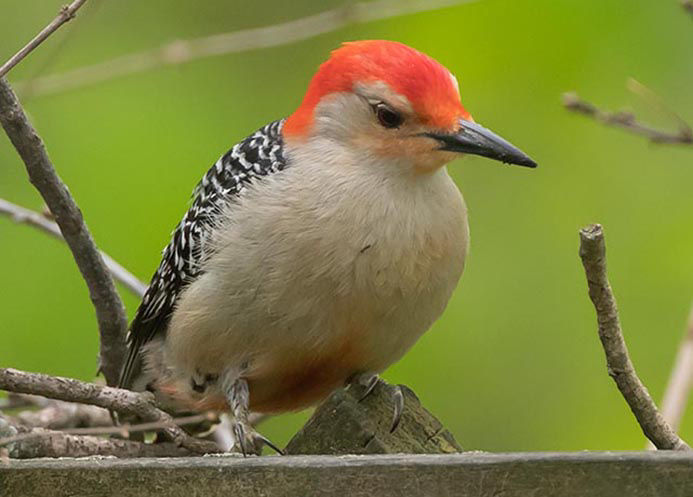Woodpeckers Unleashed: Discovering the Wonders of These Skilled Tree Mountain Climbers
Woodpeckers, with their distinct markings and balanced drumming resembling with wooded areas, hold a special area in the avian globe - Woodpeckers in Florida. As we dive into the complex information of woodpeckers' nesting practices, feeding strategies, and the continuous preservation efforts to shield these amazing birds, a much deeper gratitude for their area in nature unfolds.
Composition and Adaptations
When checking out the anatomy and adaptations of woodpeckers, one can observe impressive features that allow these birds to grow in their specialized ecological niche. Woodpeckers are furnished with a collection of unique anatomical qualities that help them in their woodpecking behavior. One of one of the most famous attributes is their solid, chisel-like beak, which is specialized for exploration right into timber to uncover insects or create nesting cavities. This beak is supported by solid neck muscles and a highly developed skull structure that serves as a shock absorber, enabling woodpeckers to repeatedly peck at trees without causing mind injury. In addition, woodpeckers have zygodactyl feet, with two toes dealing with ahead and two facing backward, offering a firm hold on tree trunks while they look for food or drum for interaction.
Furthermore, woodpeckers have an unique tongue framework that is long, barbed, and sticky, allowing them to extract insects from holes in timber. This specific adaptation permits woodpeckers to manipulate a food source that is unattainable to many various other bird types. In general, the anatomy and adjustments of woodpeckers display the amazing transformative services that have enabled these birds to flourish in their arboreal habitat.
Drumming Behavior
Having actually explored the composition and adaptations of woodpeckers, the focus currently moves to understanding their drumming habits, a distinct facet of their communication and territorial screens. Drumming is an essential type of interaction amongst woodpeckers, offering multiple objectives such as establishing areas, bring in mates, and signaling alarm system. Each woodpecker species has an unique drumming pattern that assists people acknowledge participants of their very own species and identify them from competitors or predators.
Woodpeckers produce drumming audios by rapidly pecking on resonant surface areas such as dead trees, energy poles, or perhaps steel things, developing a collection of balanced beats. The strength and rate of drumming can vary based upon the purpose; as an example, a fast drumming sequence might signify hostility in the direction of burglars, while a slower and softer drumming pattern might show courtship (Woodpeckers in Florida). In addition, woodpeckers might change the frequency and period of their drumming to share specific messages effectively
Nesting Habits
Discovering the nesting behaviors of woodpeckers exposes interesting understandings into their reproductive habits and environment options. Woodpeckers are recognized for their special nesting choices, commonly excavating dental caries in trees to create protected spaces for raising their young. These cavities serve not just as a nesting site yet additionally as a safe refuge from killers and severe climate.
Woodpeckers exhibit a high degree of fidelity to their nesting websites, often returning to the exact same area every year. This habits highlights the value of ideal habitat availability for their reproductive success. The option of a nesting site is essential for woodpeckers, with factors such as tree varieties, elevation, and degeneration phase playing significant functions in their decision-making process.
Interestingly, some woodpecker species are recognized to excavate numerous tooth cavities within their territory, giving themselves with different nesting alternatives. This technique might work as a form have a peek at these guys of insurance coverage against possible threats or disturbances to their primary nesting site.

Feeding Techniques
One of the most unique feeding actions of woodpeckers is drumming, which involves rapid pecking on trees to discover bugs under the bark. Woodpeckers are likewise understood to excavate dental caries in trees to gain access to covert insect larvae or sap. Some types, like the acorn woodpecker, shop nuts in specially developed openings called granaries.
Preservation Efforts
Among the detailed feeding techniques displayed by woodpeckers, the conservation initiatives aimed at protecting these remarkable birds play a critical duty in protecting their habitats and populaces. Woodpeckers encounter different dangers to their survival, including habitat loss due to logging, environment adjustment modifying their ecosystems, and accidents with man-made frameworks such as structures and vehicles - Woodpeckers in Florida. Preservationists are proactively working to resolve these difficulties and make sure the long-term wellness of woodpecker species

Education and public awareness campaigns are additionally crucial parts of woodpecker conservation initiatives. By raising understanding about the relevance of these birds in preserving the original source healthy forest communities, preservationists can garner assistance for environment preservation efforts and promote responsible land administration practices. Via collaborative efforts in between scientists, policymakers, and neighborhood areas, we can look what i found interact to secure a future where woodpeckers thrive in their all-natural environments.
Verdict
